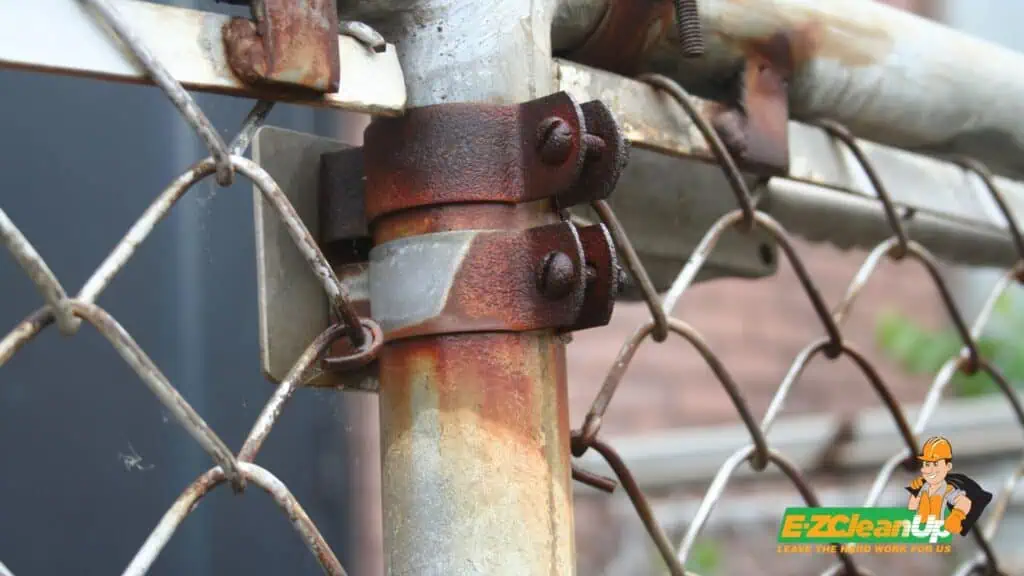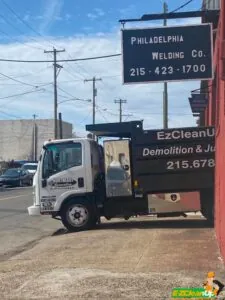To remove a chain link fence, assess the project size, gather tools like bolt cutters, and wear safety gear. Detach the fence, remove posts with tools like farm jacks, and recycle or donate the metal. Check local regulations and utility lines for a safe, compliant removal.
If you’re planning to do this project anytime soon, this article will enlighten you about the process of how to get rid of a chain link fence.
Planning Your Chain Link Fence Removal
Removing a chain link fence involves careful planning and preparation. The process can be time-consuming and physically demanding. But with the right approach, you can manage it efficiently.

Assessing the scale of the project
The first step is to evaluate the size and complexity of your fence removal project. This includes measuring the length of the fence and noting any particular challenges. These include overgrown vegetation or proximity to buildings that might complicate the removal process.
You should also consider the condition of the fence and whether any parts are reusable or need special handling due to rust or damage.
Tools and materials needed
For a successful removal, gather all the necessary tools beforehand. Essential tools include:
- Bolt cutters or wire cutters to cut the chain link fabric
- A post hole digger or shovel for extracting posts set in concrete
- A pry bar or a farm jack to remove stubborn posts
- A reciprocating saw or angle grinder if you need to cut through metal posts
- Gloves, goggles, and sturdy clothing for personal protection
Organizing these tools before starting work can significantly streamline the process and prevent delays.

Safety Precautions
Always wear protective gear, such as gloves, eye protection, and long sleeves. Ensure the work area is clear of obstacles and notify any bystanders of the work to avoid accidents.
If the posts are embedded in concrete, be prepared for heavy lifting and consider using mechanical assistance like a post puller to avoid back strain.
Understanding these key aspects and preparing adequately will help ensure that your chain link fence removal project is carried out safely and effectively.
The Removal Process
Removing a chain link fence involves several critical steps to ensure safety and efficiency, which include the following:
Detaching the Fence From Posts
To start, clear any surrounding vegetation to ensure easy access to the fence. Begin at one end of the fence, and systematically detach the tension bars and clamps. These are typically fixed to the posts with bolts that need to be loosened and removed.
After these components are detached, cut the fence ties that secure the chain link fabric to the posts. This will allow it to be rolled up and removed in sections. This helps in managing the fence’s bulk as you progress. For fences fixed with caps on the top rail, these need to be unbolted and removed to free the top rail.
Removing the Fence Posts
Once the fabric is detached, focus shifts to the fence posts. If the posts are embedded in concrete, begin by softening the surrounding earth, which can be done by soaking the base with water. This makes it easier to dig out the posts.
Using a shovel, dig around each post to expose as much of the concrete footing as possible. For stubborn posts, leverage tools like a farm jack or a post puller can be extremely helpful. This will provide the mechanical advantage needed to lift the posts off the ground.
If the concrete footing is too large or firmly set, breaking it up with a jackhammer or sledgehammer might be necessary before extraction.
Throughout this process, it’s essential to handle materials carefully to avoid injury from sharp edges and heavy components. Ensure you wear appropriate protective gear and consider engaging professional services if the task’s scale or the technical requirements are beyond your DIY capabilities.
Disposal Options for Chain Link Fences
After successfully removing the chain link fence, you can consider the following to ensure proper disposal of the materials:
Recycling the Metal Components
Recycling the metal components of a chain link fence is a practical approach to disposing of old fencing material responsibly. Here’s how you can ensure the process is both effective and environmentally friendly:
Identifying Recyclable Materials
Chain link fences are typically made from galvanized steel or coated steel wire, both of which are recyclable materials. Before recycling, it’s important to dismantle the fence and separate the metal from any non-metal components, like concrete or plastic, as these can affect the recycling process.

Choosing the Right Facility
Contact local scrap yards or recycling centers to confirm they accept the type of metal your fence is made from. Some facilities specialize in metals like steel and may offer compensation based on the current market prices for scrap metal.
Preparing for Recycling
Ensure that all non-metal parts are removed from the fence. This may involve stripping off any plastic coating and removing the fence from concrete bases or other attachments. Cleaning the metal of any debris or plant material can increase its recycling value.

Hiring a Professional Waste Removal Service
Enlisting a professional waste removal service, such as EZ CleanUp can significantly simplify the disposal process. We handle everything from sorting and lifting to hauling and proper disposal of waste.
This kind of service is hassle-free and offers the following advantages:
- Time Efficiency: Professional services can remove waste quickly and efficiently, saving you time.
- Proper Disposal: They ensure that the waste is disposed of in compliance with local regulations, reducing your environmental impact.
- Convenience: You won’t need to coordinate the logistics of transporting and disposing of large amounts of waste on your own.
Moreover, we at EZ CleanUp emphasize eco-friendly disposal methods. We aim to recycle materials wherever possible, which aligns with environmentally conscious practices.
Utilizing Local Scrap Metal Facilities
Recycling the metal components of your chain link fence at local scrap metal facilities is another practical option. These facilities typically accept metals like the galvanized steel commonly used in chain link fences.
Here’s how to proceed:
- Preparation: Separate any non-metal components from the metal parts of the fence. Clean the metal to remove any debris or soil, which could affect the price you receive for the scrap.
- Recycling Benefits: Recycling helps reduce landfill waste and conserves natural resources by repurposing metal.
- Financial Return: Depending on the current market prices and the condition of your scrap metal, you might also receive a financial return.
Before transporting your fence materials to a scrap yard, verify that they accept the specific type of metal you have. This ensures you don’t waste time or resources.
Alternatives to Disposal
When considering the removal of a chain link fence, disposal isn’t your only option. Repurposing the material can offer creative and eco-friendly solutions.
Repurposing the Chain Link Fence Material
Repurposing or upcycling old chain link fences can inject new life into your garden or home projects. Here are ways to transform the material into valuable additions:
- Garden Trellises: Chain link sections can be excellent supports for climbing plants. You can set them up as trellises in your garden to support everything from ivy and roses to beans and tomatoes.
- Animal Enclosures: Consider donating your old chain link fencing to local animal shelters or rescue centers. These organizations often need fencing to create safe, enclosed spaces for animals.
- Decorative Applications: Chain link fences can be creatively incorporated into landscape design. For instance, they can be used to make interesting yard art or as a frame for outdoor murals.
- Functional Art: Old fence posts can be repurposed into unique decorations or functional items like signposts or outdoor furniture. This approach not only recycles material but also adds a rustic charm to your property.
Donating to Community or Agricultural Centers
Donating your chain link fence can have a significant positive impact. Organizations like Habitat for Humanity ReStores accept donations of building materials, including fencing, which are then sold to fund their projects. Contacting a local Habitat for Humanity can provide details on how to donate and whether pickup services are available.
Community gardens and agricultural programs also benefit from donated fencing. These fences can be used for creating enclosures that protect community-grown produce or for constructing new agricultural sites. Involvement in community agriculture can enhance local food security and foster community connections.

Selling the Chain Link Fence
If donation isn’t a viable option, selling your chain link fence is another alternative. Selling the materials, either as scrap metal or to individuals looking for affordable fencing options, can recover some of the original investment.
Platforms like Craigslist or local scrap metal facilities are potential avenues where you can sell your fencing. This approach not only provides you with a return but also ensures the material is reused, reducing environmental impact .
Best Practices for a Smooth Removal Process
When removing a chain link fence, it’s crucial to follow best practices to ensure the process is safe, compliant with local regulations, and environmentally responsible.
Checking for Utility Lines Before Digging
Before you start digging to remove your fence posts, it’s essential to check for any underground utility lines. This precaution helps prevent accidents, service disruptions, and potential legal issues.
You should contact your local 811 call center a few days before you plan to dig. This service will mark the approximate location of buried utilities at your site, such as gas, electric, and water lines. Ensuring you’re aware of these utilities can save you from costly damages and ensure community safety.
Adhering to Local Regulations and Guidelines
It’s equally important to adhere to local regulations and guidelines when removing a fence. This includes checking for any necessary permits or restrictions related to fence removal within your community.
Local building codes can vary, and they often dictate the specifics of property modifications, including demolition activities like fence removal. Being informed and compliant with these regulations helps avoid potential fines and ensures that your removal process is legally sound.

Effortless Disposal Solutions for Chain Link Fence
Removing a chain link fence involves more than just physical labor. Many find themselves unprepared for the scale of disposal required, which can lead to unnecessary stress and potential mishandling of materials.
At EZ CleanUp, we are committed to providing an effortless disposal service for your chain link fence removal needs. Our team is well-versed in local regulations and has the tools and knowledge to ensure that your fence materials are disposed of properly.
Get in touch with us to handle the disposal of your chain link fence efficiently and responsibly.













